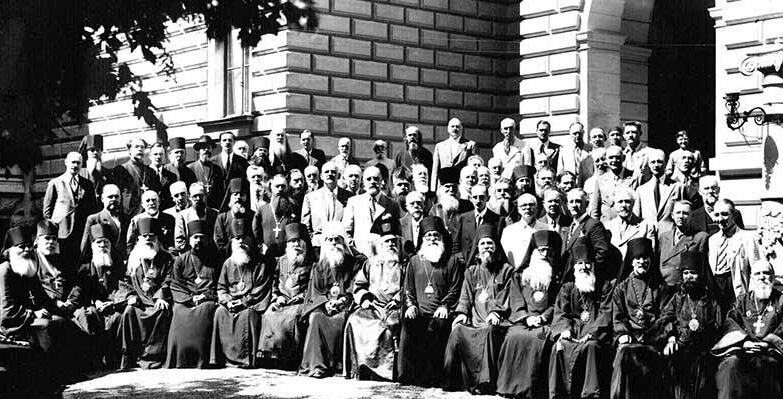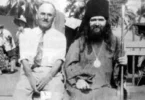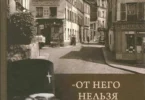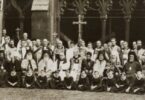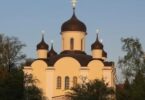Part III, Chapter 3
The Pan-Diaspora Council
Since the establishment of the Church Abroad, three Pan-Diaspora Councils have met: in 1921 and 1938 in Karlotsy, and in 1974 in Jordanville. The Stavropol Council can be added to these three Pan-Diaspora Councils, in that it founded the autonomous administration of the Southern Russian dioceses and thereby laid the groundwork for the existence of the Church Abroad. It should be made clear that in referring to these Councils — as also to the Pan-Russia Council of 1917-18 — one is referring to a local council of one of the national Orthodox Churches, as opposed to the ecumenical council of all Orthodox Churches.
The Ecumenical Council is universally accepted as the supreme assembly having authority over the rules for governance and the teaching of each and every part of the Orthodox Church. All local Orthodox Churches have the right to be represented at it. Its authority stems from Christ’s promise of the invincibility of the Church, the truth of its doctrine, and its acceptance by the Orthodox Church at large. [1] Biedermann, Zur Frage der Synode, p. 124.
Local Councils can only handle questions concerning one local Church. They differ essentially from the Ecumenical Council in that they do not deal, strictly speaking, with matters of dogma, but with the practical concerns of regulating church life.
Thus, at the Russian local Councils since 1917, matters of urgent concern to church life have always stood in the center of discussion. This is equally applicable to the Council of 1917-18 as to the Councils of the Church Abroad and the Councils of the Patriarchal Church. The latter has convened five Councils since 1917: including those in 1945, when Patriarchs Alexis I (Shimansky) was elected; in 1971, when Patriarch Pimen (Izvekov) was elected; and in 1988, for the Millenium of the Baptism of Russia. [Trans., The last was not mentioned in Seide’s original text but was contemporary with this translation, and so has been added.] It may well be assumed that in the future the only reason for convening a local council may be for the election of a new patriarch. It is the patriarch’s duty to convene a council of bishops to resolve the “more important ecclesiastical problems,” yet this occurs almost as seldom as a local council. When, in 1961, church order had to be changed under pressure from the state, the Council of Bishops met again for the first time since 1945, although these questions could really have been deliberated by a local council. [2] Struve, Christen, pp. 89-91; Patock, Bischofssynode; Voss, Bischofssynode und Patriarchenwahl.
In both of the preceding sections, it has been shown that very precise resolutions and definitions on the convocation and tasks of the Synod of Bishops and the Council of Bishops of the Church Abroad have been drawn up. Whereas the Synod of Bishops meets regularly as a governing body and the Council of Bishops is periodically convened, no such order exists for the Pan-Diaspora Council. This is because the Pan-Diaspora Councils of the Church Abroad are bound by the decisions of the Council of 1917 and, therefore, are convened when it is particularly necessary to hear the voice of the clergy and laity. It was, however, never expressly defined when such a necessity exists. Thus, for example, the Council of Bishops of 1923 maintained in its first point that it was necessary to convene a Council of clergy and laymen, [3] Nikon, Zhizneopisanie, 7, pp. 34. yet it was another fifteen years before the Council actually met. However, the reasons for the convocation were abundantly present in 1923 when, with the dissolution of the Supreme Ecclesiastical Administration, the administration of the Church Abroad had to be reorganized, and the two most important governing bodies, the Synod of Bishops and the Council of Bishops, were constituted. The convocation in 1938 finally took place in conjunction with the 950th anniversary of the Baptism of Russia, after a postponement due to the repose of the First Hierarch, Metropolitan Anthony, in 1936. The Council of 1974 met after longer preparations in view of the “newly-manifest religious reawakening of the Russian people in the homeland and, on the other hand, the rapidly advancing decline of the Christian way of life in most countries in the non-Communist world.” [4] III Gesamtkonzil, p. 11.
A significant reason for the infrequent convocation of Pan-Diaspora Councils is the enormous financial burden which they place upon the Church Abroad as a whole and upon the individual dioceses. In 1974, the Third Pan-Diaspora Council had a total cost in excess of $39,800 for the delegates’ travel arrangements, room and board, publications, administration, and other arrangements entailed by the Pan-Diaspora Council. For these expenses, $34,000 was collected through donations, $16,000 in the Eastern American Diocese alone. And these were only the expenses incurred by those who were in the United States. The cost of the travel of delegates to the United States and Jordanville, New York, the meeting-place, was borne by the dioceses, placing an additional burden on them. [5] Cf. Part III, Chap. 1, note 16.
At the Pan-Diaspora Council all bishops, as well as the elected delegates of the individual dioceses, took part: as a rule, the number of elected diocesan representatives was two clergymen and three laymen. Also included were representatives of the monasteries, and of certain ecclesiastical and academic institutions. This composition was roughly determined by the decisions of the Council of 1917-1918. [6] Chrysostomus, Kirchengeschichte, 1, p. 80. At the Stavropol Council in May of 1919, there were sixty-eighty participants: eleven archbishops and bishops, twenty-two priests, one monk, and thirty-four laymen. [7] Kandidov, pp. 42-44. At the First Pan-Diaspora Council of the Church Abroad in 1921, officially 155 people took part, though in fact, only 109 delegates were actually present: thirteen bishops, twenty-three priests, and sixty-seven laymen. [8] Deyaniya Karlovtsakh, pp. 8-15; D`Herbigny/Deubner, Evêque Russes, p. 30. An interesting description of the participants can be found in Zernov’s Sremski Karlovtsi. At the Second Pan-Diaspora Council in 1938, ninety-four people took part: thirteen bishops, twenty-three priests and monks, and fifty-eight laymen. [9] Deyaniya vtorogo sobora, pp. 6-8. At the Third Pan-Diaspora Council in 1974, 101 delegates were represented: fourteen bishops, thirty priests, four deacons, eight monks, and fifty-three laymen. [10] III Gesamtkonzil, p. 16. At the first two Councils held at Karlovtsy, there were representatives of academic and social institutions, e.g., “The Russian Academic Institute in Belgrade,” “The Palestine Society,” “The Saint Vladimir Institute,” and other institutions closely connected to the Church. To the Stavropol Council, as well as to both Karlovtsy Councils, all the participants in the 1917-1918 Pan-Russia Council living in the emigration were invited. All the participants in the Councils were men; women did not participate in any sessions.
The sessions of the Council usually lasted some ten to twelve days. For speedy handling of individual problems, working committees were formed under the leadership of a bishop. At the sessions of these working committees interested delegates had the opportunity to participate. The results were presented to the entire assembly for consent.
At the Pan-Diaspora Councils of 1921 and 1938, the Serbian Patriarch took part as the honorary president. All Serbian bishops were also invited to participate in these sessions. From the sister Orthodox Churches no representatives were invited; however, they sent written messages to the Councils. At the first Council, Metropolitan Stephen of Sofia took part in the opening session and personally delivered greetings on behalf of the Bulgarian Orthodox Church. The first Council, in 1921, stood as a marker of the foundation of the Church Abroad. A total of eight committees were established: (1) Supreme Ecclesiastical Administration Affairs Committee, Chairman, Metropolitan Anthony; (2) Parish Affairs Committee, Chairman, Bishop Michael; (3) Economic and Financial Affairs Committee, Chairman, Bishop Apollinarius; (4) Legal Matters Committee, Chairman, Bishop Theophanes; (5) Enlightenment and Education, Schools, and Printing Presses Committee, Chairman, Bishop Gabriel; (6) Mission Committee, Chairman, Bishop Seraphim; (7) Military Chaplaincy Committee, Chairman, Bishop Benjamin; and (8) Committee for the Spiritual Rebirth of Russia, Chairman, Archbishop Anastasius. [11] Deyaniya Karlovtsakh, pp. 21-23.
If one considers the individual committees and their competence, it is apparent that working groups 1-7 were concerned with the special problems of the emigration and the Church Abroad, and only one committee, the eighth, was occupied with the current and future situation in Russia. The resolutions of this eighth committee, under the chairmanship of Archbishop Anastasius led to heated discussions, especially concerning the question of the form of government and the ruling dynasty in a future Russia free of Bolshevism. These discussions, as well as the passing of a resolution concerning the irreconcilability of socialism and Christianity, [12] Ibid., pp. 84-86. the correspondence to the Genoa Conference and to the children of the Russian Orthodox Church Abroad [13] Nikon, Zhizneopisanie, 6, pp. 17-34. at the Council, have to a great extent overshadowed its true significance, as a result of which the real work of the Council has remained in the background. The real achievement of the Council was certainly the organization and consolidation of the emigration’s church life. One should not overlook the fact that the communities that existed outside Russia before 1914 no longer had any contact with their bishop in Petrograd and had been largely isolated since 1914. The continued organization of these established communities was already under threat, and a complete collapse into chaos was distinctly possible in the newly-constituted refugee communities. Whereas before the Karlovtsy Council no central ecclesiastical administration existed that could be supported through the general recognition of the emigration, this situation changed within a few weeks of the Council’s conclusion. Practically all émigré bishops and the Russian bishops in Poland, the Baltic Republics, Finland, the Far East, and America recognized the competence of the church leadership in Karlovtsy. Without a doubt, the Council had contributed substantially to this.
Considering that the majority of refugees expected their emigration to be temporary and were awaiting the speedy collapse of the Soviet system, it is admirable that the Council constructed plans for the organization of the spiritual, educational and administrative aspects of church life that had enduring value. Thus, particular attention was given to the religious education of the refugees. The special situation of the diaspora in non-Orthodox countries was also discussed in detail. The internal mission needed to be strengthened in order to protect the faithful from the influences of the Protestant and Catholic Churches, sects, and pseudo-religious ideas. By establishing church schools and printing presses, by consolidating parish life, and by providing special training for priests in the new circumstances prevailing in the diaspora, the faithful would be protected from alienation from their own Church and culture. [14] Deyaniya Karlovtsakh, pp. 44-46, 72-75. New sects such as the Seventh-Day Adventists and the Baptists were viewed as particularly dangerous, followed by anti-Christian and God-hating Freemasonry and militant Catholicism. [15] The Jesuits and the “propaganda fide” are seen as representatives of militant Catholicism. The faithful were also warned against the false prophecies and promises of materialism as represented by Socialism, Communism, and Bolshevism. The most important measures to be taken against this threat was, above all else, to be the intensifying of Church-sponsored work among youth, which included, besides catechetical instruction, the setting up of Orthodox youth groups and groups of children and teens, dedicated to questions of Faith, and based upon the teachings of the Orthodox Church and Russian cultural traditions. [16] Deyaniya Karlovtsakh, pp. 76-80. The parishes were entrusted with the execution of these tasks.
The establishment and administration of the parishes were based on the parish by-laws of 7/20 April 1918, which were adopted by the Council of 1917-1918. [17] Ibid., p. 81. After the Council at Karlovtsy, the goal and tasks of the parishes were defined to provide a spiritual and material union for the mutual help and support of the faithful. The parishes were also to ensure the protection of children from non-Orthodox influences and make preparations for a return to Russia. Besides performing Divine Services, parish work was to consist of education and instruction and charitable and benevolent work. [18] Ibid., p. 42. The leadership and oversight of several communities were entrusted to a bishop. In this connection, the creation of new dioceses for the administrative consolidation of several parishes was discussed. Petitions were presented at this discussion by the refugee communities in Greece and France, which requested the Council to send a bishop. [19] Ibid., pp. 46-53. Further discussions on this point, produced the “Decree on the Russian Diocesan Administration Abroad” of 17/30 November 1921, which entrusted the administration of Russian Church communities in the individual provinces to a bishop, who was to rule the province in agreement with the Holy Councils and Canons. A diocesan council should exist at the bishop’s side, which should have as elected representatives at least three clergymen and two laymen or, in case of necessity, two clergymen and one layman. Thus, the Council created the administrative basis — parochial and diocesan — requisite for the building-up of the emigration’s church life. [20] Ibid., pp. 81-83.
The central leadership of the Church Abroad, as already mentioned, was transferred to the Council and the Synod. Many of the measures decided upon by the Council were realized only years later (e.g., the establishment of printing presses, the formal education of priests). However, the Council did serve as a guide for further ecclesiastical developments in the 1920s and had a lasting influence on the Church Abroad for decades to come. There had been plans to convene a Second Pan-Diaspora Council since 1923, but it was postponed for some fifteen years. The reason for this lay in the developments within the Church Abroad after 1924-26, as the pretension to autonomy on the part of the Western European and North American Dioceses led to the fateful schisms of the emigration. These attempts at reunification, which were at least successful in the case of the North American Metropolia, led to the convocation of the Second Pan-Diaspora Council. At this Council, only the Western European communities under Metropolitan Eulogius were not represented, though in 1938 only a small minority of the church emigration as compared with the Church Abroad, which represented some 90% of the Church-organized émigrés. 1 The Council, therefore, claimed to represent the “whole Russian emigration.” In summarizing the Council in the newspaper Orthodox Russia (1938, No.17-18), Archimandrite Seraphim (Ivanov, later Archbishop) writes that the Council presented a picture of complete unanimity and agreement of all opinions and views; the more conservative representatives had collaborated on the individual working committees with the more liberal in total harmony. They had found a common language, a unity of interests. The Council had in this way demonstrated its creative strength, the unity of the Church, its spiritual greatness and radiance. [21] In addition to the collected volumes Deyaniya vtorogo sobora, detailed reports on the Council appeared in Prav. Rus´ (1938) 17-18 (Sept.) through 24 (Dec.).
The complete agreement of views was in direct contrast to the First All-Diaspora Council in 1921, at which the resolutions of the committee chaired by Metropolitan Anastasius had led to forcefully expressed differences of opinion. At the Second Council, only strictly ecclesiastical and religious questions were discussed. The reports delivered on the situation of the Russian Church in the Soviet Union, as well as on the difficult situation of the faithful, were not likely to elicit protests, as they expressed the convictions and views of the participants. At the Council, a total of thirty reports were read, seven protocols of the sessions’ minutes were signed, and two epistles to the faithful in the homeland and in the emigration were composed. Two reports dealt with ecclesiastical and religious developments in the Soviet Union and were read at the beginning of the Council. [22] Deyaniya vtorogo sobora, pp. 58-123. Count Grabbe (later Bishop Gregory) added a report on the relationship between the Church Abroad and the Moscow Patriarchate. [23] Ibid., pp. 124-143. The subsequent reports covered the situation of the emigration and were concerned with the establishment of a Russian national and cultural center for the emigration to preserve its spiritual and cultural heritage since the Bolsheviks were systematically destroying this heritage in the homeland. [24] Ibid., pp. 147-169. Subsequently, the education of priests and the material situation of the clergy, as well as care for the elderly, were discussed. [25] Cf. Part IV, Chap. 4. Further reports dealt with the religious upbringing of the youth, for whom their own school system should be established, and the broadening of catechetical courses. [26] Cf. Part IV, Chap. 5. Dismay was expressed over the general slackening of church discipline, especially amongst the intelligentsia, who in part intentionally maintained an “estranged ignorance” of church rules. The clergy called on the faithful to follow church rules and pointed to the ecclesiastical penalties incurred by their violation thereof. [27] Deyaniya vtorogo sobora, pp. 253-287. Bishop Seraphim (Lade, later Metropolitan) read three reports: “On the Ecumenical Movement,” “The Oxford Conference,” and “Catholicism and Bolshevism”. N. F. Stepanov enlarged upon these later in two reports concerning the relationship between “The Vatican and the Ecumenical Movement” and “Judeo-Catholic Rapprochement and Further Perspectives in the Development of the Ecumenical Movement as a Consequence.” [28] Ibid., pp. 295-350, 492-556.
The relationship to the ecumenical movement and the condemnation thereof led to lengthy debates. Two separate directions crystallized out of this: one which rejected any contact with ecumenism and wanted to forbid the laity to participate in the conferences and organizations of this movement in any way, while the other group favored attendance at ecumenical meetings in order to clarify the Orthodox standpoint to non-Orthodox confessions. In the debate, no agreement was reached, so this problem was to be handed over to the Council of Bishops for further deliberation. The decisions on the Oxford Conference, which had concerned itself with the “burning questions” of Christendom in the world, were utterly rejected because its statements concerning the capitalist form of the economy had glossed over the realities of the Communist system and could have led to a false assessment thereof. The Conference’s attempt to discover Christian ideals of equality and brotherhood in Marxist economic practices completely ignored the facts of Soviet reality. The Pope had made a realistic assessment of Bolshevism, as emphasized in the encyclical “Divini Redemptoris,” in which the struggle against Bolshevism was announced.
Further reports dealt with the relationship of the Church Abroad to its sister Orthodox Churches, [29] Cf. Part V. the situation of the Orthodox Churches since the end of World War I, the “Persecution of Orthodoxy in Poland,” and the “Eastern Rite” churches in union with Rome. Particular attention was paid to Rome’s attempt to bring Orthodox Christians to the Unia. This attempt had taken the form of persecution of the Orthodox in some countries in the past.
Two further reports dealt with the situation of Metropolitans Eulogius’s Paris Jurisdiction. Count Grabbe disputed the canonical basis of the Paris Jurisdiction and denied that it had any right to subordinate itself to the Ecumenical Patriarchate. Archbishop Seraphim denounced the teachings of Father Sergius Bulgakov, which the Council condemned as heretical. [30] Deyaniya vtorogo sobora, pp. 177-192. Naturally, the condemnation of Bulgakov’s teachings was in equal measure a condemnation of the Saint Sergius Institute in Paris and ultimately Metropolitan Eulogius. This condemnation meant that after 1938 a rapprochement became all the more unlikely.
The 1938 Pan-Diaspora Council had, in barely two weeks, taking decisions on all the important questions of contemporary church life. Whereas at the First Pan-Diaspora Council the building-up of the Church Abroad had been the central issue, and the delegates at the Second Pan-Diaspora Council had again to deal with the strengthening of the emigration’s church life, the relations of the Church Abroad to the other Christian denominations stood much more in the foreground of the discussions. This Council also clarified the independence of the Church Abroad, which for the almost twenty years since its establishment as the Church in exile had stood on its own. The Council determined the basic features of its position with regard to the Ecumenical Movement and the Roman Catholic Church. While the delegates differed in appraising involvement in the Ecumenical Movement, most of them concurred in the criticism of the Roman Catholic Church. Whereas the Church Abroad remained a regular observer at the conferences of the Ecumenical Movement into the 1950s, this changed upon the entry of the Moscow Patriarchate and the other Churches of the Soviet bloc countries into the World Council of Churches, when the Church Abroad, fearing (not without justification) a strong politicization of the World Council of Churches, withdrew. [31] Cf. Part V, Chap. 4. The real achievement of the Second Pan-Diaspora Council lay, however, in the fact that the delegates succeeded in strengthening the inner life of the Church Abroad to the extent that in the subsequent years of war, during which contact between the dioceses and the church leadership was cut off, the Church Abroad was able to survive this.
The Third Pan-Diaspora Council met in Jordanville in 1974. The Council was opened with solemn divine services on 8 September, at which fourteen bishops, more than forty priests and deacons, the brotherhood and seminarians of Holy Trinity Monastery, and many of the laity, took part. No other divine service had included so many hierarchs and clergy since the 1938 Council. The Council ended with a service of thanksgiving in the New York Synodal Cathedral. There the Council of Bishops was convened and ratified all the decisions, resolutions, and epistles of the whole assembly. [32]On the course of the Council, the reports and resolutions, this time — in contrast to the years 1921 and 1938 — no comprehensive volumes were published. There was a plan to publish a book in … Continue reading
At the Council, thirty reports were presented, and ten resolutions were passed. In contrast to the Council of 1938, however, the developments in the Ecumenical Movement and of the Catholic and Protestant churches were only discussed peripherally. Only three reports dealing with this theme: Father Alexander Lebedev spoke about the latest developments in the Reformed Churches, particularly studying the North American Protestant Churches; Archpriest Rostislav Gan gave a survey of the Ecumenical Movement since the entry of the Churches from the Soviet bloc countries; and finally, Professor S. Grotov spoke about the tendencies towards modernism within the Roman Catholic Church, which had led to a crisis in Catholicism.
At the focal point of the reports and discussions was the Russian Orthodox Church. After a detailed report by Metropolitan Philaret on events in the life of the Church Abroad since the Council of 1938, Archpriest George Grabbe discussed the canonical foundations of the Church Abroad. Two further reports covered the situation of the Church Abroad in modern society (Archbishop Antony of Geneva) and the preservation of Russian traditions throughout the diaspora (Priest Vladimir Shishkoff). The missionary work of the Church Abroad [33] Part IV, Chap. 6. in the diaspora and its efforts to reach the faithful in the homeland by sending religious publications, broadcasting radio programs, and making contacts with Soviet citizens formed a large part of the discussions.
The situation of the younger generation was discussed. On the problem of youth in the diaspora, Archbishop Seraphim of Chicago and Detroit, Bishop Nectarius of Seattle, and the leaders of five Russian youth organizations in exile (including the Russian Scout Movement, Orthodox Action, and others) reported on youth work in and out of school. G. Lukianov, the inspector of church schools in the Diocese of Eastern America, emphasized the significance of the church school system, while Archbishop Seraphim evaluated the positive experiences of summer and winter camps of Russian youth. In these vacation camps, which were operating in some dioceses, young people from the ages of eight to sixteen were gathered and experienced more closely the life of the Orthodox Church and the cultural traditions of their fathers.
In connection with a letter from Alexander Solzhenitsyn to the Council, the situation of the Russian Church in the homeland and the schisms of the Church were discussed at length. [34]The wording of the letter and an answer by Archpriest George Grabbe are given in III Gesamtkonzil, pp. 20-39. An interpretation of the exchange of letters in Fr. Chrysostomus’s view can be found in … Continue reading
Solzhenitsyn agreed with the condemnation of Metropolitan Sergius’ declaration, which he described as an unconditional capitulation which made it easier for the authorities to carry out “the planned, stealthy destruction of the Church.” He also confirmed the misuse of the Moscow Patriarchate by the government for political, cosmetic ends, and for interference in international church affairs. He warned the Church Abroad, however, against falsely evaluating the religious situation in the Soviet Union. The role of the “Catacomb Church,” whose earlier existence he confirms and whose revival he foresees if the State repression of the Church increases, was stressed. In connection with this, he warned against a too far-reaching condemnation and rejection of the official Church, a “Church in chains, an enslaved Church, one pressed against the floor, but in no way a fallen Church.” The unworthy hierarchs of the Church do not disturb the Body of the Church, “nor the numerous faithful priests and the masses of worshipers in the Church.” This Church has brought forth many confessors, before whom it bows down. After these words, the respected writer and dissident turned to the situation of the Church emigration. He acknowledged with pain the schism of the Church in diaspora: “The most important facts of this discord, however, I know, and it appears to me that each of the Churches (struggling with one another) has a discernible canonical basis, with which fault can be found, as well as the Moscow Patriarchate with its consequences. No one will find unconditional, indisputable canonical rights… Which danger is unhealthier for Russian Orthodoxy — external suppression by force or inner collapse through disunity?” The cause of this discord and the collapse of the Russian Church as a united entity, Solzhenitsyn sees in the situation of the Russian Church at the outbreak of the Revolution, because it was too weak to stand as a united body above the political parties. In the spiritual unity of the Russian Church alone, in the union of its physical and spiritual strength, lay the hope for a revival of Russia and of the Russian people. In order to help the Russian Church in the homeland most effectively, the free Russian Orthodox Church in exile must overcome its divisions and bury its strife. [35] III Gesamtkonzil, pp. 20-24.
In his answer to this letter, Archpriest George Grabbe indicated that those in the Church Abroad must always distinguish between the unworthy hierarchs such as Metropolitan Sergius and worthy faithful and priests. One must consider as “catacomb clergy” in the broadest sense all those priests who administer the Mysteries without demanding the registration of the faithful.
Yet now as before, there are priests who are active outside the Patriarchal Church, acting as “catacomb priests.” As for the schism of the emigration, Father Grabbe pointed above all else to the denationalization of the Paris and American groups, where Russian traditions were being increasingly suppressed. He corrected the writer’s false evaluation of the future role of the Church Abroad in a liberated Russia: “Solzhenitsyn also errs in this, that we ostensibly count on returning to Russia as a judge or a commander. I know no one who feels and thinks this way. We have long since had little hope that Russia will again be free at all… But we see ourselves as a part of the Russian Church, albeit even such a small part. Therefore we very much hope to be represented at a freely assembled Russian Council, if such becomes possible. [36] Grabbe means that the Paris Exarchate and the OCA can no longer be represented at All-Diaspora Council because both have renounced their Russian origins by splitting from the Russian Church. How great, however, will our weight at such a Council be, none of us have even taken into consideration.” [37] III Gesamtkonzil, p. 58.
A further point which Solzhenitsyn touched upon in his letter concerned the Old Ritualists. He regretted their condemnation and anathematization by the Russian Church. The Council resolved, therefore, to take under consideration that the Council of 1917-1918 was unable to leave behind a written resolution on this matter, but had practically decided to lift the ecclesiastical ban — the ex-communication and ban of the Councils of 1666 and 1667 were against individuals — as nullified and to consider it as invalid from the beginning. [38] Ibid., pp. 55-58; Prav. Rus´ (1974) 23, pp. 6-7.
Appeals for reunification were addressed to the Paris Jurisdiction and to the “Orthodox Church in America,” which, however, in both cases sadly met with no results, since all three Churches held to their standpoints. [39] III Gesamtkonzil, pp. 47-50, pp.51-544, pp. 69-72. Cf. Part V, Chap. 2. The ten resolutions passed by the Council were directed to the faithful. In them were called to strengthen the Church and the Faith. The relationship to the Moscow Patriarchate, the canonical basis of the Church Abroad, the situation of the Orthodox Church in the modern world, the goals and tasks of the faithful and of the Church by helping their oppressed co-religionists in the homeland and, lastly, two resolutions on the significance of the ecclesiastical printing presses and the Church educational system for the missionary tasks of the Church Abroad were discussed. [40] The wording of the resolutions are found in Prav. Rus’ (1974) 21, pp. 11-13; 22. pp. 13-14.
In a special epistle to the faithful, the bishops reported on the results of their deliberations and mentioned their exchange of letters with Alexander Solzhenitsyn. The bishops spoke in this epistle of the religious renaissance impending in Russia and exhorted their own faithful to stand firm in the Orthodox Faith because only the Faith can lead “to a renewal of mankind, which today is in such confusion.” [41] III Gesamtkonzil, pp. 40-46.
With this epistle, the Council ended its session. Archbishop Antony of Geneva wrote an epistle to his faithful, stating that this Council was more “than merely a council of the diaspora because the living forces of today’s Russia had contributed to its success. At the Council, the voice which had formerly been silent — the voice of our homeland tested by suffering — resounded. As such a voice, the writers Alexander Solzhenitsyn, Vladimir Maximov, and Andrei Sinyavsky — Christian of conviction and great artists — are counted with the foremost sons of our land. . . This experience of a genuine connection to the homeland gave the Council particular significance, lifted it up to a higher plane than that of our existence in the diaspora. Many perceived the Council as the first step towards a Pan-Russian Council.” [42] Ibid., p. 16.
References
| ↵1 | Biedermann, Zur Frage der Synode, p. 124. |
|---|---|
| ↵2 | Struve, Christen, pp. 89-91; Patock, Bischofssynode; Voss, Bischofssynode und Patriarchenwahl. |
| ↵3 | Nikon, Zhizneopisanie, 7, pp. 34. |
| ↵4 | III Gesamtkonzil, p. 11. |
| ↵5 | Cf. Part III, Chap. 1, note 16. |
| ↵6 | Chrysostomus, Kirchengeschichte, 1, p. 80. |
| ↵7 | Kandidov, pp. 42-44. |
| ↵8 | Deyaniya Karlovtsakh, pp. 8-15; D`Herbigny/Deubner, Evêque Russes, p. 30. An interesting description of the participants can be found in Zernov’s Sremski Karlovtsi. |
| ↵9 | Deyaniya vtorogo sobora, pp. 6-8. |
| ↵10 | III Gesamtkonzil, p. 16. |
| ↵11 | Deyaniya Karlovtsakh, pp. 21-23. |
| ↵12 | Ibid., pp. 84-86. |
| ↵13 | Nikon, Zhizneopisanie, 6, pp. 17-34. |
| ↵14 | Deyaniya Karlovtsakh, pp. 44-46, 72-75. |
| ↵15 | The Jesuits and the “propaganda fide” are seen as representatives of militant Catholicism. |
| ↵16 | Deyaniya Karlovtsakh, pp. 76-80. |
| ↵17 | Ibid., p. 81. |
| ↵18 | Ibid., p. 42. |
| ↵19 | Ibid., pp. 46-53. |
| ↵20 | Ibid., pp. 81-83. |
| ↵21 | In addition to the collected volumes Deyaniya vtorogo sobora, detailed reports on the Council appeared in Prav. Rus´ (1938) 17-18 (Sept.) through 24 (Dec.). |
| ↵22 | Deyaniya vtorogo sobora, pp. 58-123. |
| ↵23 | Ibid., pp. 124-143. |
| ↵24 | Ibid., pp. 147-169. |
| ↵25 | Cf. Part IV, Chap. 4. |
| ↵26 | Cf. Part IV, Chap. 5. |
| ↵27 | Deyaniya vtorogo sobora, pp. 253-287. |
| ↵28 | Ibid., pp. 295-350, 492-556. |
| ↵29 | Cf. Part V. |
| ↵30 | Deyaniya vtorogo sobora, pp. 177-192. |
| ↵31 | Cf. Part V, Chap. 4. |
| ↵32 | On the course of the Council, the reports and resolutions, this time — in contrast to the years 1921 and 1938 — no comprehensive volumes were published. There was a plan to publish a book in English (cf. Prav. Rus’ (1974) 22, p. 13), yet this did not materialize. All reports and documents on the III Council are in the Synod archives in file 2/72; all reports on preparations are in file 1/71. G2W published a special issue in German entitled Die Russisch Orthodoxe Kirche im Ausland. Ihr III Gesamtkonzil 1974. Mit Solzhenitcyns Rede (Zürich 1974). Also, reports on the Council appeared in Prav. Rus’ (1974) 21, pp. 11-13; 22: pp. 13-14; Tserk. Zhizn’ (1974) 7-12, pp. 13-16; (1975) 1-6, pp. 7-112, as well as in many other periodicals of the Church Abroad. |
| ↵33 | Part IV, Chap. 6. |
| ↵34 | The wording of the letter and an answer by Archpriest George Grabbe are given in III Gesamtkonzil, pp. 20-39. An interpretation of the exchange of letters in Fr. Chrysostomus’s view can be found in Ostkirchliche Studien and in his Solzhenitsyn and Gesamtkonzil. On Solzhenitsyn’s relationship to the Patriarchal Church, C. Patock published an essay in the same periodical: Patock, “Solzhenicyn.” |
| ↵35 | III Gesamtkonzil, pp. 20-24. |
| ↵36 | Grabbe means that the Paris Exarchate and the OCA can no longer be represented at All-Diaspora Council because both have renounced their Russian origins by splitting from the Russian Church. |
| ↵37 | III Gesamtkonzil, p. 58. |
| ↵38 | Ibid., pp. 55-58; Prav. Rus´ (1974) 23, pp. 6-7. |
| ↵39 | III Gesamtkonzil, pp. 47-50, pp.51-544, pp. 69-72. Cf. Part V, Chap. 2. |
| ↵40 | The wording of the resolutions are found in Prav. Rus’ (1974) 21, pp. 11-13; 22. pp. 13-14. |
| ↵41 | III Gesamtkonzil, pp. 40-46. |
| ↵42 | Ibid., p. 16. |

